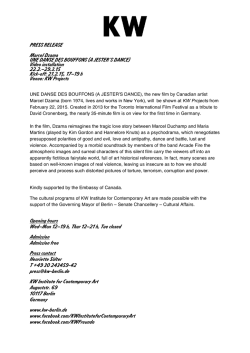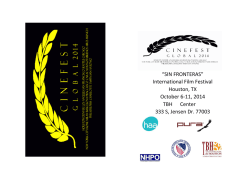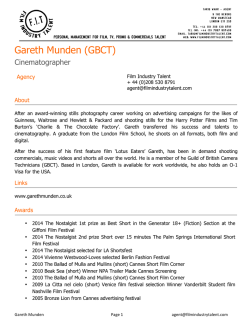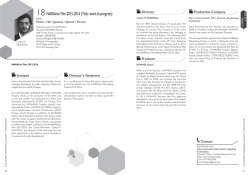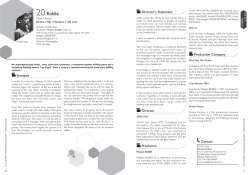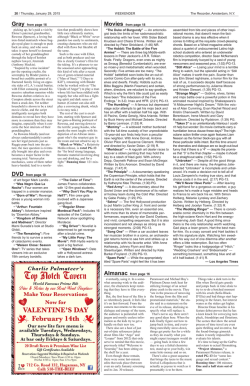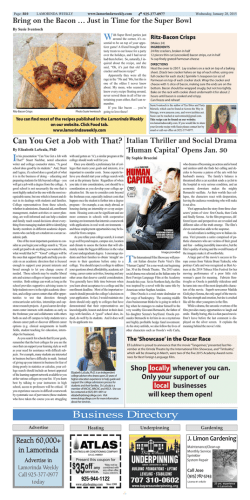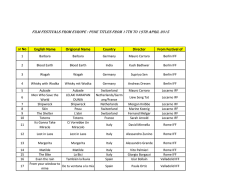
White Shadow Film
SYNOPSIS AND DIRECTOR’S STATEMENT WHITE SHADOW is the story of Alias, a young albino boy on the run. After witnessing his father’s murder, his mother sends him away to find refuge in the city. He’s brought to the care of his uncle, Kosmos, a truck driver struggling with a few small businesses. In the city, Alias is a quick learner, selling sunglasses, DVDs and mobile phones. He is fond of his uncle’s daughter, Antoinette, although his uncle disapproves. Gradually the city becomes no different than the bush and wherever Alias travels the same rules of survival apply. Since 2007 it has become known that Albinos in Tanzania have become a commodity – human targets of a lucrative and sinister trade. Witch doctors offer thousands of dollars for albino body parts which are believed to bring good fortune, prosperity and the ability to cure any illness. As a result, Tanzanian albinos, including children, have been murdered by gangs of men who hack off arms, legs or genitals. Some will pay from $500 to $5000 for an albino limb while the average annual income in Tanzania is $442. There is a saying in East Africa, “Albinos don’t die, they just disappear.” Seventythree such documented killings have occurred in the past two years as well as hundreds of unreported attacks since 2007. “While preparing to teach in Dar Es Salaam, I learned about the hunting of albinos in East Africa. I decided a film must be made: a real chronicle of a young person with a price on his head, a person who has to urgently become aware of his own condition against events that can end his life. In a certain circumstance, you can witness what it feels to be a beast to react, to be alert to your utmost ability. You must accept the solitude of your dreams as your friend and as a form of survival details of the plot should be only what the character is able to understand and piece together, the politics and cultural information should be delivered in a sensory form. To make the film work we needed to be small, local and quick-moving, making sure everyone was safe and brave.” Noaz Deshe CREDITS CAST Hamisi Bazili (Alias) / James Gayo (Kosmos) / Glory Mbayuwayu (Antoinette) Salum Abdallah (Salum) / Tito D. Ntanga (Father) / Riziki Ally (Mother) James P. Salala (Adin) / John S. Mwakipunda (Anulla) FILMMAKERS Director / Noaz Deshe Screenplay / Noaz Deshe, James Masson Cinematography / Armin Dierolf, Noaz Deshe 2nd Camera / Nassos Chatzopoulos Editing / Noaz Deshe, Xavier Box, Robin Hill, Nico Leunen Music / James Masson, Noaz Deshe Sound / Elie Chansa, Niklas Kammertöns, Thomas Wallmann Costumes / Sandra Leutert, Caren Miesenberger Art Direction / Smith Kimaro, Deepesh Shapriya Line Producers / Vanessa Ciszewski, Francesca Zanza Producers / Ginevra Elkann, Noaz Deshe, Francesco Melzi d’Eril Production / Asmara Films, Shadoworks, Mocajo Film Coproducers / Alexander Wadouh, Matthias Luthardt, Babak Jalali Coproduction / Chromosom Filmproduktion, French Exit, Phantasma Films, Real2Reel, with the support of Nipkow Programme, Goethe-Institut Tanzania, Alliance française Dar es Salaam Executive Producers / Ryan Gosling, Stefano Gallini-Durante Associate Producers / Matteo Ceccarini, Eva Riccobono, Luigi De Vecchi, Depart Foundation, Andreas Hommelsheim Format / DCP, colour, 1:1.85 Runtime / 115 min. FESTIVAL SELECTIONS & AWARDS Venice Critics Week 2013 – Winner of the Lion of the future for the Best Film Debut Selected in Sundance World Competition 2014 GENEVA Black Movie Festival – Prix Boréal du Public Göteborg IFF VILNIUS IFF, KINO PAVASARIS Curacao International Film Festival Rotterdam Jerusalem FF – competition Zanzibar Film Festival 2014 Durban IFF – competition KARLOVY VARY 2014 – Variety Critics’ Choice Hungary – Cineast IFF Finland – Helsinki Intl’ Film Festival Love & Anarchy France – Etrange Film Festival competition Istanbul Film Festival Turkey – 21th Golden Boll International Film Festival BARCELONA INTERNATIONAL AUTEUR FILM FESTIVAL Canada – Calgary IFF MOOOV Belgium – competition NASHVILLE IFF – New Directors competition SFIFF – SAN FRANCISCO FILM SOCIETY – SPECIAL JURY PRIZE Seattle IFF Art Film Fest – competition Transilvania IFF, Cluj – SPECIAL JURY MENTION USA – SpectreFest Los Angeles Canada – Montreal Nouveau Cinema IFF Brazil – Sao Paulo IFF UK – Africa in Motion UK – Film Africa Ireland – Cork IFF USA – Denver IFF Estonia – Tallinn Black Nights International Film Festival “Zerkalo” – BEST DIRECTOR AWARD India – Goa IFF Munich Film Festival – competition Serbia – Auteur Film Festival – awarded UK, East End Film Festival – competition Austria – This Human World Film Festival Galway Film Fleadh – competition Era New Horizons Wroclaw IFF – competition Mexico – Morelia IFF ABOUT THE MAKING OF “WHITE SHADOW”, AN INTERVIEW WITH DIRECTOR NOAZ DESHE Why did you choose this story for your debut film? The importance of this story and the challenges of making it work with little means are a very strong engine. Maybe I can answer that in the future. Right now I can say it came in loud and clear as something that is urgent. It must be made and made now. The idea dictated the rules and gave an endless source of energy to keep going into a lot of unknowns, which was very thrilling. Why did you choose cinema as a means for your artistic expression? Cinema is not the only way for me to communicate ideas, but if the opportunity arrives to combine all these things I love, then it is a real joy. There is a romantic wish that when you set out to make a film, that it will take you far deep down into what you do not know, expand and break what you do and teach you things about how you perceive your surroundings. If a story can offer, even a little, of that within your process, then you have to do it. It is a way you can get lost inside ideas in their nonverbal form, a vacation from daily thinking. There are numerous documentaries about the stories of African Albinos. Is there any one in particular who inspired you? Why did you choose to make a fiction film instead? The Tanzanian BBC journalist Vicky Ntetema, who won a Courage in Journalism Award for her reporting on the situation of Albinos there, was the first inspiration for me when I read about her. The more I researched and read into the subject, the clearer it became that the only way I could create an experience of what it means to be in a situation like this would be a fiction film with strong roots in reality. Fiction allows you to focus on small details and tune the story to the essential. It also allows you to be free with experimentation because you dance around your narrative thread. You can go there with documentary, but it’s much harder to tune it exactly as the idea dictates. Approaching the film with a screenplay allowed me to be free with everything that is documentary around it, because I could keep the narrative thread and be sure the characters’ stories would carry you through the chaos. I knew that shooting in Africa demanded a very open approach. Scheduling has to be fluid and nothing is certain, but you must accept everything you lose as a gift. Your creative process is constantly negotiating between reality and the plot points you wish to enforce upon it. I find it a very thrilling way of working because it helps you check your credibility with sensitive material, and helps you to see clues that you are following the correct intuitive choices. The screenplay was written very quickly, did you immediately think of the character of Alias? Why did you choose the perspective of a young boy to tell the story? Yes, he was called Alias in the first thought and the main story was very clear because it arrived one night as a set of images of Alias running and what he does in order to hide. The images had to be written down and drawn. It was called White Shadow, and it was a real chronicle of a young person with a price on his head, a person who has to urgently become aware of his own condition in the face of events that could end his life. This was very vivid even as an abstract idea. The film has a very distinctive style, in some aspects it’s similar to reportage, such as the use of the handheld camera, and in others it’s very refined, such as the work with sound and the choices of frames and cuts. Why did you choose this combined approach? The only conscious technical decision I made was to try to make it credible, that it should be truthful to the details of that particular reality. I don’t really know what that means, apart from describing something that is not in sync and suddenly snaps into sync. It’s not one of those things you find in the ether. It is very subjective. But based on intuitive reactions to the research and a lot of fact checking – some things just look more right. We had to be very reactive with all of the technical aspects. Heavy equipment can weigh you down. It’s something to avoid when shooting with non-professional actors and children in particular, so we kept that part very light. We used mostly one camera except for big crowd scenes, and mostly available light or hand held flashlights. Everything we shot had to be set up, rehearsed and written. But once it is set up and everyone knows how they maneuver, then you forget it all and react to it as if it’s happening in front of you for the first time. It’s a very exciting dance between reacting and forgetting. I enjoy being a participating audience so it’s a lot of fun for me to work that way. As for the music in the film, I wanted its role to be to emote the mental and physical condition of Alias, to be an echo of his character. As with the story itself the idea was to keep it experiential, to stay sensory and keep asking questions. Can you talk about the casting process? In 2010, a friend, Matthias Luthardt, invited me to join him to teach a short film course in Dar Es Salaam, Tanzania’s capital in East Africa. Goethe Institute Tanzania and Alliance Francaise were hosting us, and the objective was to make a short film with a group of 40 local talents that had signed up. Having a background as a researcher for other films, I began by reading all sources of local news and blogs and I very quickly encountered an issue which takes the center stage in Tanzania’s media, the human hunting and persecution of Tanzanian albinos for witchcraft. From there, the idea for the film came very quickly and I met many collaborators through the initial course and workshop. Francaise gave us their building, and every night it was full of people playing out, scenes from the film. Nassos Chatzopoulos, a Greek Tanzanian Director and Cameraman who participated in the workshop, was our anchor in Dar Es Salaam. He opened his home to us and brought all his friends and colleagues to help us. He introduced me to Hashim Rubanza who helped me cast the film. Hashim and I would go during rush hour to a ferry that crosses from the rural to modern part of the city. There we would street cast, based on gut feelings. For example, we walked into the fishmarket and saw a guy that was sitting on a chair bossing all the other fishermen and being very calm, and we invited him to be one of the people in the gang. It was an exhilarating guessing game – we challenged each other on how many interesting strangers we could convince to come to a screen test. We developed a spiel, and after a few hours we had a routine. Everyday we played out abduction scenes and bank robberies, home invasions and love spats with people that came from our street adventures. There was also Andrew Panja, a great local character and our “fixer” that brought more performers, usually his relatives. We ended up casting his brother. Tito, who plays Alias’ father in the film, was the only person in the crew with regular stage experience, as he is the head of a dance and song group that brings awareness to the Albino cause, called The Albino Revolution Cultural Troupe. We traveled around different cultural centers looking for the kids that would play Alias and Salum. We did dream workshops where we first did a short interview then we would talk about dreams. The kids that stuck out as storytellers stayed. We were very lucky to meet Hamisi (who plays Alias) in a workshop we did in collaboration with Tito. Hamisi was waiting for us, prepared with a song he wrote about his life. We kept filming with him for a few days to make sure he could work with preconditioned situations. He was phenomenal. When I told him that we would make the film with him, he nodded. A girl in the room asked him “Why are you not smiling? Aren’t you happy?” He answered “It’s not necessary to smile in order to show happiness” and then he laughed. That was it. It was very hard to find the girl that would play Antoinette. We saw maybe 400 girls, whole schools came and we shot scenes with each and every one of them. Glory Mbayuwayu came along with her twin sister and her mother. Both Glory and her sister Grace are exceptional actresses possessing natural professional behaviors as to how to approach working with people. They are extremely smart and very focused. In her audition, I asked Glory to rob a bank while Hamisi would play the teller. It was so impressive that we shot another scene that brought me to tears. I understood she had a range and capability to share emotions, raw and without any filters. When I tested her against other actresses later it was clear that she was the only one in the room. There was never a moment the camera did not wish to follow her own story. What were your most satisfying and most difficult moments on set? One day we changed our schedule at the last moment and went to shoot in a different location. Where we did not go, a lion killed ten people. The army shot him. I keep thinking about this lion running through a very poor and condensed area. Maybe that was his first time and he is realizing that humans are easy to catch, their skin is not tough like wild animals, perhaps when it comes down to it he needs to do this more often because he has been pushed away from his natural habitat, and at the moment of his eureka, he gets shot by the army. There were many difficult moments… One night we heard artillery and found out that an old military weapons depot was exploding. Missiles flew into the international airport and surrounding villages. One of the kids that was acting in the film, Willy Wilson, had to escape his home when bombs where landing on his head. He got hurt and would not speak for a month. Crew members contracted malaria and aggressive skin rashes, severe food poisoning. And never for one moment did I think, we cannot do it. The doubts and worries keep you alert and solving problems. The entire process is adjusting to new realities every day. The entire crew was extremely committed. Everyone was on a mission pushing each other to make it work. No one questioned the reasons or way to make it. We kept up that energy and it kept us going. There were times we had to shoot with many people. It is a big test of your conviction. You knock on every door and announce a village meeting and then bring everyone into the process and make something out of nothing, with a group of people you met a few hours ago and suddenly all agree to share one fantasy. And everyone has his own. It is, in its positive form, the most playful and beautiful thing humans can do. Drop everything that weighs them down and commit to a total fantasy and play. Adapted from an interview by Anna Maria Pasetti in the 2013 Venice Film Festival Critic’s Week Catalogue ABOUT THE FILMMAKERS NOAZ DESHE (Director/Co-Writer/Music/Cinematography) Noaz Deshe is a Berlin and Los Angeles-based filmmaker, musician, artist and producer. He composed the soundtrack of “Frontier Blues” (2009), the debut feature by Iranian director Babak Jalali. His debut graphic novel In Case We Never Meet is awaiting publication. “White Shadow“ is his debut feature film. He enjoys very much to be involved in every aspect of the movie, he shoot and compose as well. Shot a documentary in Gazza – Area K Directed a Video art experimental short about Hermanphrodite dreams called BoysGirls (AFI film fest) Directed one hour long Sci/Fi documentary Search Agent Zerox Worked as Cinematographer, Writer, Composer (Frontier Blues, Toto and his sisters, White shadow) Executive producer - Lost River 2010 performed what he dubs as “haunted folk music” in character as “Ghost Cowboy” served as the opening act for Dead Man’s Bones. JAMES MASSON (Co-Writer/Music) Multi-instrumentalist and Composer James Masson is originally from Australia. Based in Europe for the past decade, his musical projects range from the atmospherics of funereal act Sibling Lovers to the cacophony of Danmatsuma, an international group based in Melbourne at the turn of the century. James began constructing his own musical instruments at age 5, building an electric stringed instrument out of Meccano and parts scavenged from his Grandfather’s collection of electronic components. In the 90’s, James created experimental films using 16mm, projectors and video processed through guitar effects. In these works the soundtrack was generated by the image directly. Bringing experience gained behind mixing desks from Melbourne to Berlin to bear on his work as a composer of music is only natural for this Antipodean, who marries painfully beautiful turns of musical phrase with noise; balancing compositions delicately on the knifes edge between beauty and terror. ”White Shadow” is James’ first feature film composition. ABOUT THE FILMMAKERS (CONTINUED) ARMIN DIEROLF (Cinematographer) Born in 1978 in Waiblingen, south of Germany, Armin Dierolf learned his trade under acclaimed cinematographers Sophie Maintigneux (Eric Rohmer), Hans Fromm (Christian Petzold), Christian Berger (Michael Haneke) and Michael Ballhaus A.S.C (Martin Scorsese) at the German Film and Television Academy Berlin (dffb). In addition to numerous short films, Armin lensed the documentary features “In the year of the dog” (Ursula Scheid), “Dancing Alone” (Birnur Pilavci) and “Lighter Than orange” (Matthias Leupold, 2012). After graduating from the dffb in 2011, Armin was Director of Photography on fiction features “Cold Sunday” (Ivan Pokorny), “Petting Zoo” (Micah Magee) and “Sivas” (Kaan Müdjeci). Armin Dierolf was awarded the German Cinematography Award while still a student in 2006. His work has been screened at Cannes; Camerimage in Lodz; the Venice Film Festival; and was awarded “Best Cinematography” at the International Short Film Festival Sehsüchte in 2009. In 2012, Armin’s dffb thesis film “Headlock” (Johan Carlsen) won the New Berlin Film Award for best mid- length feature and in 2013, the documentary “Dancing Alone” won the New Berlin Film Award for best feature documentary. The TIDE Experiment is a collective venture gathering several players in the European film industry. The main goal is to release films simultaneously in at least 5 territories using Day-and-Date distribution models: meaning the film launch on VOD platforms and cinemas on the same date. More info available on www.thetideexperiment.eu facebook.com/TheTIDEExperiment twitter.com/TIDE_Experiment
© Copyright 2025
